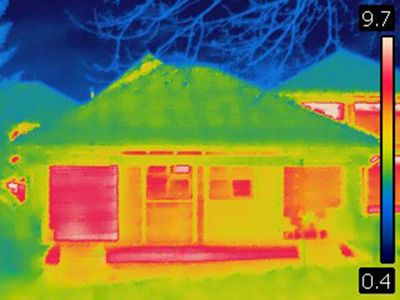What is Thermography?
What is it and How Does it Work?
Thermography, also known as infrared thermography, is a technique that uses infrared cameras to detect and visualize heat patterns and temperature differences on a surface. Every object emits infrared radiation as a function of its temperature. Thermography captures this radiation and converts it into a thermal image or thermogram, displaying a gradient of colors that correspond to different temperatures.
Thermography is non-contact, non-invasive, and provides real-time data, making it ideal for monitoring and diagnosing systems, structures, and equipment without causing any disruption.
Thermography relies on specialized infrared cameras that detect the infrared radiation emitted by objects. The camera’s sensors measure the intensity of the radiation and assign a corresponding temperature to each point in the field of view. These temperatures are then mapped into a visual display where hotter areas might appear red or yellow, and cooler areas appear blue or green.
This technique is widely used in industries like construction, manufacturing, electrical systems, healthcare, and even roofing inspections.

Advantages of Thermography

Thermography provides a wealth of benefits that make it indispensable for many applications. Here are some of its key advantages:
- Non-Destructive and Non-Invasive
Thermography allows inspections and diagnostics to be carried out without damaging the object or structure being examined. This is particularly valuable for sensitive equipment or materials. - Early Problem Detection
Thermography helps identify potential issues—such as overheating, insulation gaps, or electrical faults—before they become critical. Early detection can save significant time, money, and resources. - Improved Safety
By identifying issues like overheating components or electrical faults, thermography prevents accidents such as equipment failure or fire, ensuring a safer environment for workers and users. - Energy Efficiency
Thermography is an effective tool for pinpointing energy inefficiencies, such as heat loss in buildings or leaks in HVAC systems. By addressing these issues, businesses and homeowners can reduce energy consumption and lower costs. - Versatility Across Industries
Thermography has diverse applications, including:
- Electrical Inspections: Locating hotspots in circuits or connections.
- Building Diagnostics: Identifying heat loss, moisture intrusion, or structural defects.
- Healthcare: Detecting abnormal temperature patterns in the body, aiding in diagnostics.
- Manufacturing: Monitoring machinery for overheating or improper operation.
- Roofing: Detecting trapped moisture or damaged insulation.
- Real-Time Results
Thermography provides immediate insights, allowing technicians to make quick decisions and take corrective actions without waiting for lab results. - Cost-Effective Maintenance
By identifying and addressing problems early, thermography reduces the need for costly repairs, downtime, or replacements.
This website uses cookies.
We use cookies to analyze website traffic and optimize your website experience. By accepting our use of cookies, your data will be aggregated with all other user data.